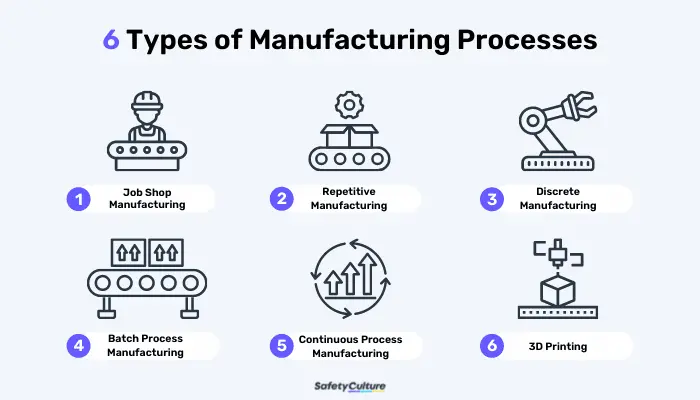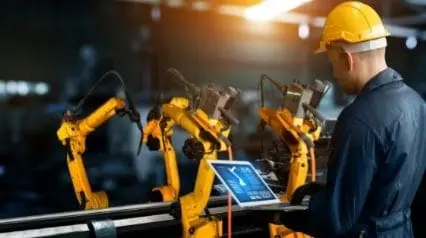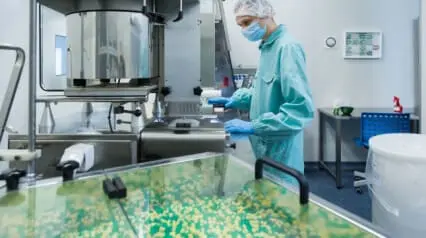What are Manufacturing Processes?
Manufacturing processes refer to the ways a business or organization creates products. Involved in these processes are various manufacturing methods, machinery, tools, and different kinds of operations software for scheduling and production control, among others.
Depending on the type of products being manufactured, the methods involved in the entire manufacturing process may be considered simple or complex and require varying levels of supervision, automation, and control. The needed resources and manpower can also differ to meet the unique needs of traditional manufacturing processes or even advanced manufacturing processes. Moreover, computers, robots, and cloud-based technology are responsible for the automation of the stages involved in the overall manufacturing system, helping make it streamlined and efficient in the long run. In the bigger picture, Good Manufacturing Practices (GMP) cover every aspect of common manufacturing processes to combat risks and promote quality and workplace safety.
General Classifications
Prior to knowing the various types of manufacturing processes, it’s important to understand the 2 major classifications they may fall under. This way, organizations can further identify the type of process that best fits their production needs, customer demands, and sales forecasts. Read on to learn more about each classification.
Processing Operations
This classification of manufacturing processes pertains to the transformation of completed work materials to an advanced form or state. This is done by adding value through the means of changing the shape, physical appearance, or chemical composition, bringing the work material closer to the desired finished component or product. In most cases, processing operations are done on individual components or parts.
Assembly Operations
Also known as the joining process, this classification is the method of combining two or more components or parts to create a new entity. Assembly operations are further broken down into two main methods: permanent and semi-permanent.
Permanent assembly operations are used to combine components that are required to remain together or not supposed to be easily disconnected. On the other hand, semi-permanent assembly operations are done using mechanical operations and components like screws and bolts to make it easier to disconnect components as needed.
What are the 6 Different Types of Manufacturing Processes?

6 Types of Manufacturing Processes
There are different manufacturing processes that are proven to work depending on the industry you’re in, the type of product or business, and the overall goals. Here are the 6 main types that are most commonly used by organizations across industries worldwide.
1. Job Shop Manufacturing
Instead of working in an assembly line, different workers are assigned to separate workstations, workshops, or production areas. The product, before it reaches its completion stage, must go through each of the stations so that each worker can add value to it before going on to the next.
Products that are best manufactured using the job shop type often require unique methods or sequences of stages, making the process ideal for customization or made-to-order production. Small batches are often produced through job shop manufacturing.
Since this type tends to give a stronger focus on quality control, it can be slower as it produces lower-volume yet highly-customized products. These include, but are not limited to specialized aviation parts, ship components, and even industrial machinery. With this, highly trained professionals handle job shop manufacturing processes to take charge of advanced techniques, which are being utilized to achieve quality standards.
Create Your Own Quality Control Checklist
Eliminate manual tasks and streamline your operations.
Get started for FREE2. Repetitive Manufacturing
Typically used by mass production industries such as electronics and automotive to name a few, this type of manufacturing refers to the creation of the same or similar products on an assembly line.
Companies that use this type maintain high consideration for constant consumer demand for the products they manufacture. Since there is such stability, repetitive manufacturing is known for its ability to improve the overall speed and efficiency of manufacturing processes.
Furthermore, this is best for companies that have a committed production rate, with production and assembly lines functioning almost 24/7 throughout the year. It’s also crucial to note that, when compared to job shop manufacturing, this type tends to cater to a high volume of products and utilizes automation to increase efficiency and decrease costs simultaneously.
3. Discrete Manufacturing
Being closely related to repetitive manufacturing, discrete manufacturing also utilizes assembly or production lines. However, the latter is more complex as it’s designed to adapt to frequent modifications over time.
To cater to the ever-changing customer demands and technological advancements, configurations on the assembly or production lines must be done on a regular basis. Manufacturers of clothing, toys, and medical devices are some examples that require this type, as they need to add or eliminate certain components or methods being applied to their current products to account for necessary innovations brought on by trends and demands. Discrete manufacturing is also closely tied to the concept of One Piece Flow, which is used in lean manufacturing processes.
Designing and regularly updating a business resumption plan is critical for companies in discrete manufacturing, as changes in production can quickly render a business unable to operate.
4. Batch Process Manufacturing
Manufacturing one batch can be considered enough to meet consumer demand, as opposed to constantly manufacturing the same or similar products since this may likely result in overproduction. After one batch production, manufacturing equipment and tools are then cleaned and prepared for the next batch.
In summary, batch process manufacturing is closely related to how discrete (meeting consumer demand) and job shop (availability of raw materials and custom products) manufacturing processes work. Moreover, this type of manufacturing process is commonly used in food production and pharmaceuticals, to name a few.
5. Continuous Process Manufacturing
Generally, this is similar to repetitive manufacturing in the sense that it runs 24/7 too. The kind of raw materials used in continuous process manufacturing is what makes it different. Gases, liquids, powders, and granule materials (mining) are the most common ones. Hence, some examples of where this process is best applied are oil refining and fertilizer production.
6. 3D Printing
Being widely recognized as the sixth type of manufacturing process due to its uses and the great potential it brings across industries, 3D printing is being utilized by many organizations using different composites and materials such as plastic and metals. These are then used to build products, often three-dimensional, based on digital models and by means of a layer-by-layer method. In today’s market, 3D printing is evident in products including medical devices, firearms, and lifestyle items such as shoes and cosmetics.




